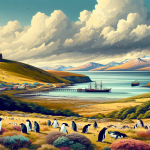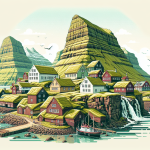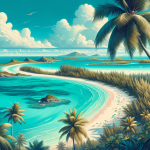South Georgia and the South Sandwich Islands: A Remote Paradise
South Georgia and the South Sandwich Islands, a remote and rugged archipelago in the Southern Atlantic Ocean, offer a unique and unforgettable travel experience. These islands are known for their dramatic landscapes, abundant wildlife, and historical significance. While they may not be the easiest destinations to reach, the effort it takes to visit this remote paradise is well worth it. In this article, we will explore the wonders of South Georgia and the South Sandwich Islands, including their history, natural beauty, and the incredible wildlife that calls these islands home. Whether you are an adventurous traveler seeking a once-in-a-lifetime experience or a nature enthusiast eager to witness some of the world’s most pristine ecosystems, South Georgia and the South Sandwich Islands are sure to leave a lasting impression.
The History of South Georgia and the South Sandwich Islands
Early Exploration and Discovery
South Georgia and the South Sandwich Islands have a rich history of exploration and discovery. The islands were first sighted by Captain James Cook in 1775 during his second voyage to the Southern Hemisphere. Cook named the largest island, South Georgia, in honor of King George III of England. The South Sandwich Islands, a group of smaller volcanic islands located to the southeast of South Georgia, were also discovered by Cook and named after John Montagu, the 4th Earl of Sandwich.
Whaling and Sealing Era
In the early 19th century, South Georgia became a hub for the whaling and sealing industries. Whalers and sealers from various countries, including Britain, Norway, and the United States, established stations on the island to process their catches. The whaling industry, in particular, had a significant impact on the island’s economy and environment. Whales were hunted extensively in the surrounding waters, leading to a dramatic decline in whale populations. By the mid-20th century, the whaling industry had collapsed, and the stations were abandoned. Today, visitors can explore the remnants of these early whaling stations, which serve as a reminder of the island’s industrial past.
Scientific Research and Conservation
In recent decades, South Georgia and the South Sandwich Islands have become important sites for scientific research and conservation efforts. The islands are home to several research stations, including the British Antarctic Survey’s King Edward Point station. Researchers study a wide range of topics, from climate change and glaciology to the behavior and ecology of the island’s wildlife. Conservation efforts have also been implemented to protect the islands’ unique ecosystems and restore populations of native species. These efforts include the eradication of invasive species, such as rats and reindeer, which have had a detrimental impact on the island’s native flora and fauna.
Natural Beauty and Geography
Stunning Landscapes
The landscapes of South Georgia and the South Sandwich Islands are truly breathtaking. South Georgia, the largest island in the archipelago, is characterized by rugged mountains, glaciers, and deep fjords. The island’s highest peak, Mount Paget, rises to an impressive 2,934 meters (9,626 feet) and is often covered in snow and ice. The island’s coastline is dotted with dramatic cliffs, sandy beaches, and sheltered coves, providing a stark contrast to the icy interior. The South Sandwich Islands, on the other hand, are a chain of volcanic islands, many of which are still active. These islands are characterized by their rugged terrain, with steep slopes and rocky outcrops. The volcanic activity has created unique geological features, such as lava flows and fumaroles, adding to the islands’ dramatic beauty.
Glaciers and Icebergs
One of the most striking features of South Georgia is its glaciers. The island is home to over 160 glaciers, which cover approximately 50% of its land area. These glaciers flow from the island’s mountainous interior down to the sea, where they calve into icebergs. The sight of these massive ice formations is truly awe-inspiring, and visitors to the island often have the opportunity to witness this natural spectacle up close. The icebergs that break off from the glaciers can vary in size and shape, from small, jagged chunks to massive, towering structures. The icy blue color of the icebergs contrasts beautifully with the surrounding landscape, creating a stunning visual display.
Flora and Fauna
Despite its harsh climate, South Georgia and the South Sandwich Islands are home to a surprising diversity of flora and fauna. The islands’ unique ecosystems support a wide range of plant and animal species, many of which are found nowhere else on Earth. The coastal areas of South Georgia are covered in tussock grass, which provides important habitat for nesting seabirds and seals. The island’s interior is dominated by mosses, lichens, and hardy alpine plants, which are adapted to the cold, windy conditions. The South Sandwich Islands, with their volcanic soil, support a different range of plant species, including hardy grasses and mosses that can withstand the harsh environment.
Wildlife of South Georgia and the South Sandwich Islands
Seabirds
South Georgia and the South Sandwich Islands are a haven for seabirds, with millions of birds nesting on the islands each year. The islands are home to several species of albatross, including the wandering albatross, which has the largest wingspan of any bird. Other seabird species found on the islands include petrels, prions, and skuas. The islands’ cliffs and rocky outcrops provide ideal nesting sites for these birds, and the surrounding waters are rich in fish and krill, providing an abundant food source. The sight of thousands of seabirds soaring above the islands or nesting in large colonies is a truly spectacular sight and a highlight of any visit to the islands.
Penguins
One of the main attractions of South Georgia is its penguin colonies. The island is home to several species of penguins, including king penguins, gentoo penguins, and macaroni penguins. King penguins, in particular, are a major draw for visitors, with some colonies numbering in the hundreds of thousands. The sight of these majestic birds, with their striking black and white plumage and bright orange markings, is truly unforgettable. Visitors to the island can observe the penguins as they go about their daily activities, from nesting and feeding to molting and chick-rearing. The penguins are often quite curious and unafraid of humans, allowing for close-up encounters and incredible photo opportunities.
Seals and Whales
In addition to seabirds and penguins, South Georgia and the South Sandwich Islands are home to several species of seals and whales. The islands’ beaches and coastal waters are frequented by fur seals and elephant seals, which come ashore to breed and molt. The sight of these massive animals, with their distinctive calls and playful behavior, is a highlight of any visit to the islands. The surrounding waters are also home to various species of whales, including humpback whales, southern right whales, and orcas. Whale-watching tours are a popular activity for visitors, offering the chance to see these magnificent creatures up close in their natural habitat.
Visiting South Georgia and the South Sandwich Islands
Getting There
Reaching South Georgia and the South Sandwich Islands is no small feat, as the islands are located in a remote and inhospitable part of the world. Most visitors arrive by ship, either as part of a dedicated expedition cruise or as a stop on a longer voyage to Antarctica. Several companies offer expedition cruises to the islands, departing from ports in South America, such as Ushuaia in Argentina or Punta Arenas in Chile. These cruises typically last several weeks and include guided excursions and activities on the islands. Due to the islands’ remote location and challenging weather conditions, it is essential to choose a reputable and experienced tour operator to ensure a safe and enjoyable trip.
When to Visit
The best time to visit South Georgia and the South Sandwich Islands is during the austral summer, from November to March. During this time, the weather is relatively mild, with temperatures ranging from -2°C to 8°C (28°F to 46°F), and the days are long, providing ample daylight for exploration and activities. This period also coincides with the breeding season for many of the islands’ wildlife species, offering the best opportunities for wildlife viewing. However, it is important to note that the weather in this region can be highly unpredictable, with strong winds, heavy snowfall, and rough seas common even during the summer months. Visitors should be prepared for a range of weather conditions and pack accordingly.
What to Do
There is no shortage of activities and experiences to enjoy on South Georgia and the South Sandwich Islands. Wildlife viewing is undoubtedly the main attraction, with the chance to see penguins, seals, seabirds, and whales in their natural habitat. Guided excursions, led by experienced naturalists and guides, provide opportunities to learn about the islands’ unique ecosystems and observe wildlife up close. Hiking and trekking are also popular activities, with several trails offering stunning views of the island’s landscapes and opportunities to explore its rugged terrain. For those interested in history, visiting the remnants of the whaling stations and the gravesite of Sir Ernest Shackleton, the famous Antarctic explorer, are must-see attractions. The islands’ dramatic scenery and abundant wildlife make them a paradise for photographers, with endless opportunities to capture stunning images.
Conservation and Sustainability
Protecting the Environment
Conservation and sustainability are of paramount importance in South Georgia and the South Sandwich Islands. The islands’ fragile ecosystems are highly susceptible to the impacts of human activity, and efforts are being made to minimize these impacts and protect the islands’ natural heritage. The South Georgia Heritage Trust and the Government of South Georgia and the South Sandwich Islands have implemented several conservation initiatives, including the eradication of invasive species, habitat restoration, and the establishment of marine protected areas. These efforts have led to significant improvements in the health of the islands’ ecosystems and the recovery of native species populations.
Responsible Tourism
Visitors to South Georgia and the South Sandwich Islands are encouraged to practice responsible tourism to help preserve the islands’ pristine environment. Tour operators adhere to strict guidelines to minimize their impact on the islands, including limiting the number of visitors, ensuring that waste is properly managed, and maintaining a safe distance from wildlife. Visitors are also encouraged to follow the principles of Leave No Trace, which include respecting wildlife, staying on designated trails, and taking all waste with them when they leave. By practicing responsible tourism, visitors can help ensure that South Georgia and the South Sandwich Islands remain a pristine and untouched paradise for future generations to enjoy.
Conclusion
South Georgia and the South Sandwich Islands are truly a remote paradise, offering a unique and unforgettable travel experience. The islands’ dramatic landscapes, abundant wildlife, and rich history make them a must-visit destination for adventurous travelers and nature enthusiasts. While reaching these remote islands may require some effort and careful planning, the rewards are well worth it. Whether you are exploring the remnants of the whaling stations, observing the incredible wildlife, or simply taking in the stunning scenery, South Georgia and the South Sandwich Islands are sure to leave a lasting impression. By practicing responsible tourism and supporting conservation efforts, visitors can help protect this fragile environment and ensure that it remains a pristine and untouched paradise for future generations to enjoy.
For more information on planning your visit, check out the South Georgia and the South Sandwich Islands official website.








